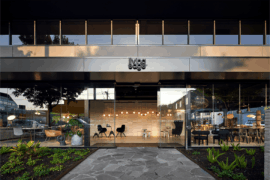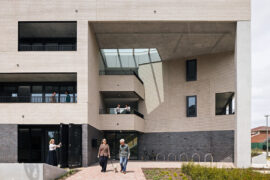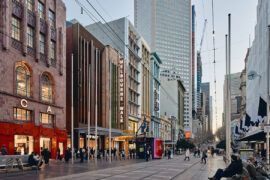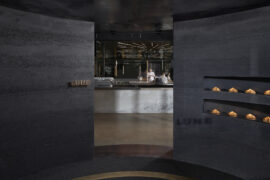The latest instalment of fjcstudio’s Truth and Lies talk series looked at ‘The Consciousness of Architecture and the Will of the Architect’.

January 24th, 2024
fjcstudio, in collaboration with the Australian Institute of Architects (AIA) and University of Technology Sydney (UTS), continued its stellar talk series with another busy event at The Mint in Sydney to round out 2023. On this occasion, it was also sponsored by Think Brick Australia.
Taking its cues from Richard Francis-Jones’ book, ‘Truth and Lies in Architecture’, the inaugural event investigated ‘The Fencing of Architecture and the Villa of the Architect’. The sequel turned attention towards the question of consciousness in relation to architecture. Obviously a wide topic, Francis-Jones chose in his opening lecture to focus on – and problematise – distinctions between living beings and non-living things. The immediate relevance to architects seems to be threefold: technically, in terms of the treatment of materials; ethically, in terms of the treatment of other beings and things; and personally, in terms of the individual designer’s ego or will.

Louis Kahn’s famous prompt – ‘what does a brick want to be?’ – was used as a way into the discussion in Francis-Jones’ lecture: “Is it in the asking of this question that the builder becomes an architect, when we see life and consciousness beyond our own designer wilfulness?”
It’s a provocation that undermines the architect’s claim to be the most important, or only, source of consciousness in the building of something. While that hubristic image might be evolving into something of an anachronism, its dangers doubtless live on – in the relegation of manual construction labour as unskilled, for example, or in the mistreatment of animal life and indeed all natural matter. In an age of climate catastrophe, the question of expanding our notion of consciousness takes on critical urgency.
Related: Q&A on politics with Elizabeth Farrelly

Instead of focussing on the individual designer, the opening lecture positioned a different question as front and centre: that of imbuing architecture with life. What if designers were defined less by willpower and more by their capacity to endow and uncover consciousness?
“Rather than separate ourselves from nature, objectifying it for instrumental use, an environmental philosophy of empathy that extends sentience deep into the natural world – in many ways supported by Indigenous thought and philosophy – is more intuitive and natural to our own sense of being,” said Francis-Jones.
“It is surely the natural insight of our children. This same insight is central to the art and nature of the craft of architecture, and it is hardly surprising therefore that all children are architects.”

Our modern, rationalist conceptions of consciousness are traced back to Enlightenment philosophy, the Cartesian dualism that draws a neat line between mind on one side and body, or matter, on the other. The ravages of this kind of materialist, scientific positivism are all to plain to see in the form of climate breakdown, alienation and endless commodification. The talk asked the simple question: what if those kinds of lines had never been drawn?
Responding to the lecture was a panel featuring Elizabeth Farrelly, William Smart and Shannon Foster, while Anthony Burke once again moderated the discussion. More events are expected for this year and, in the meantime, you can watch a full recording of ‘The Consciousness of Architecture and the Will of the Architect’ here.
fjcstudio
fjcstudio.com
Photography
Courtesy of fjcstudio




INDESIGN is on instagram
Follow @indesignlive
A searchable and comprehensive guide for specifying leading products and their suppliers
Keep up to date with the latest and greatest from our industry BFF's!

A curated exhibition in Frederiksstaden captures the spirit of Australian design

For Aidan Mawhinney, the secret ingredient to Living Edge’s success “comes down to people, product and place.” As the brand celebrates a significant 25-year milestone, it’s that commitment to authentic, sustainable design – and the people behind it all – that continues to anchor its legacy.

Brett Ward, General Manager of Marketing at Brickworks, tells us how modern approaches to sustainability are intersecting with the long history of the brick.

Seven years in the making, the new Surry Hills Village is here with doors open and crowds gathering.
The internet never sleeps! Here's the stuff you might have missed

Buchan weaves heritage and contemporary retail across a 3,600sqm site featuring dual-branded hotels, arcades and revitalised laneways.

Cieran Murphy has been awarded The Photographer – Commercial at the INDE.Awards 2025. His work on Lune Rosebery captures the immersive design and storytelling of the space, highlighting the interplay of form, material and atmosphere in this contemporary culinary destination.